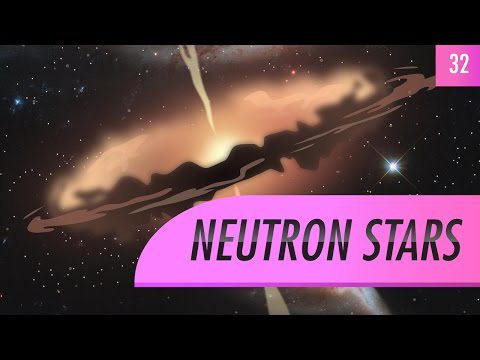În urma dispariției unei stele cu masă solară de 8-20, găsim un mic obiect ciudat cunoscut sub numele de stea neutronică. Stelele neutronice sunt incredibil de dense, se rotesc rapid și au câmpuri magnetice foarte puternice. Unele dintre ele le vedem ca pulsari, fulgerând în luminozitate în timp ce se învârt. Stelele neutronice cu cele mai puternice câmpuri magnetice se numesc magnetare și sunt capabile de explozii colosale de energie care pot fi detectate pe distanțe mari.
Consultați posterul despre sistemul solar Crash Course Astronomy aici: http://store.dftba.com/products/crashcourse-astronomy-poster
—
capitole:
Introducere: Neutron Stars 00:00
Degenerarea electronilor 0:51
Degenerarea neutronilor 1:28
Caracteristicile stelei cu neutroni 2:24
Pulsari 5:56
Magnetari 8:15
Revizuire 11:48
—
PBS Digital Studios: http://youtube.com/pbsdigitalstudios
Urmărește-l pe Phil pe Twitter: https://twitter.com/badastronomer
Doriți să găsiți Crash Course în altă parte pe internet?
Facebook – http://www.facebook.com/YouTubeCrashCourse
Twitter – http://www.twitter.com/TheCrashCourse
Tumblr – http://thecrashcourse.tumblr.com
Asistență CrashCourse pe Patreon: http://www.patreon.com/crashcourse
—
FOTOGRAFII/VIDEOCLIPURI
Star Burst https://svs.gsfc.nasa.gov/cgi-bin/details.cgi?aid=11447 [credit: NASA’s Goddard Space Flight Center]
Imagini cu raze X ale G292.0+1.8 http://chandra.harvard.edu/resources/animations/snr.html/?page=8 [credit: X-ray: NASA/CXC/Penn State/S.Park et al.; Optical: Pal.Obs. DSS]
Secțiunea transversală a stelei neutronice https://www.cursuriaz.ro/wp-content/uploads/localimages/a-3ENeutron_star_cross_section.jpg [credit: NASA]
Fermi observă „Superflares” în Nebuloasa Crabului https://www.youtube.com/watch?v=qDhdwgK218E [credit: NASA/Goddard Space Flight Center]
Ce este un pulsar? https://www.youtube.com/watch?v=gjLk_72V9Bw [credit: NASA’s Goddard Space Flight Center]
Jocelyn Bell http://blog.sciencemuseum.org.uk/insight/2013/03/20/1960-discovery-of-pulsars/ [credit: National Media Museum / Science & Society Picture Library]
Faruri de lumină cu raze X https://www.youtube.com/watch?v=6p2OGc6a_TQ [credit: NASA/JPL-Caltech]
Chandra Time-Lapse Film http://chandra.harvard.edu/photo/2002/0052/animations.html [credit: NASA/CXC/ASU/J.Hester et al.]
Satelitul Fermi de la NASA găsește indicii de cutremur în „Furtuna” Magnetar http://www.nasa.gov/content/goddard/nasas-fermi-satellite-finds-hints-of-starquakes-in-magnetar-storm [credit: NASA’s Goddard Space Flight Center/S. Wiessinger]
Swift de la NASA dezvăluie un nou fenomen într-o stea cu neutroni http://www.nasa.gov/mission_pages/swift/bursts/new-phenom.html#.Vcp-6flVhBe [credit: NASA’s Goddard Space Flight Center]
Explozie cosmică a doua numai după Soare în luminozitate https://svs.gsfc.nasa.gov/cgi-bin/details.cgi?aid=20077 [credit: NASA/Goddard Space Flight Center Conceptual Image Lab]
Cursuri interesante:
- High Mass Stars: Crash Course Astronomy #31
- Stele binare și multiple: Crash Course Astronomy #34
- Black Holes: Crash Course Astronomy #33
- Stars: Crash Course Astronomy #26
- The Sun: Crash Course Astronomie #10
- Clustere stelare: Astronomie de curs accidental #35
- Tides: Crash Course Astronomy #8
- Observații cu ochiul liber: Astronomie de curs accidental #2
- Exoplanetele: curs accidental de astronomie #27
- Pământul: curs accidental de astronomie #11

The bigger question is, would flying into one of the jets really overclock your FSD without turning you into jelly?
I LOVE this series. I'm an avid watcher of "How the Universe Works" and I love Phil in that series. But here I've learned much more detail than the TV series. Phil's enthusiasm for astronomy and teaching is wonderful and very engaging. I happened upon these YouTube videos by accident, and I'm very glad I did!
Magnetars are are magnetic versions of black holes
That's a great explanation. Other channels rattle down the facts, but I've never learned about the issue of star quakes before. 🙂